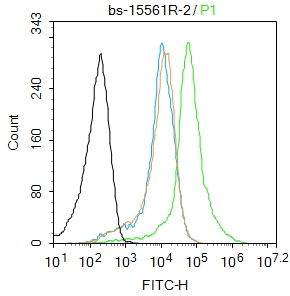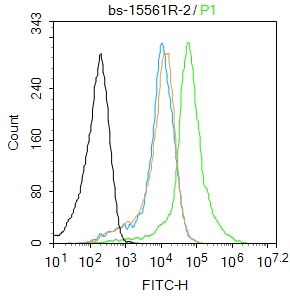IFT20 Rabbit pAb
IFT20 Rabbit pAb
- 产品详情
- 实验流程
- 背景知识
| Primary Accession | Q8IY31 |
|---|---|
| Reactivity | Rat, Pig, Rabbit, Horse |
| Host | Rabbit |
| Clonality | Polyclonal |
| Calculated MW | 15281 Da |
| Physical State | Liquid |
| Immunogen | KLH conjugated synthetic peptide derived from human IFT20 |
| Epitope Specificity | 1-100/132 |
| Isotype | IgG |
| Purity | affinity purified by Protein A |
| Buffer | 0.01M TBS (pH7.4) with 1% BSA, 0.02% Proclin300 and 50% Glycerol. |
| SUBCELLULAR LOCATION | Golgi apparatus, cis-Golgi network (By similarity). Cytoplasm, cytoskeleton, centrosome, centriole (By similarity). Cytoplasm, cytoskeleton, cilium basal body (By similarity). Note=Present at the centrosomes during the cell cycle and associated with the proximal portion of the mother centriole and the lateral aspect of the daughter centriole. Associated with basal body at the base of primary cilia (By similarity). |
| SUBUNIT | Component of IFT complex B composed of IFT88, IFT57, TRAF3IP1, IFT52, IFT27, HSPB11 and IFT20. Interacts directly with IFT57 and KIF3B/Kinesin II subunit (By similarity). Interacts with CCDC41/CEP83. |
| Important Note | This product as supplied is intended for research use only, not for use in human, therapeutic or diagnostic applications. |
| Background Descriptions | IFT20 is a gene encodes a intraflagellar transport protein important for intracellular transport. The encoded protein forms part of a complex involved in trafficking of proteins from the Golgi body, including recycling of immune signalling components (Finetti et al., PubMed: 19855387). This gene is part of a complex set of sense-antisense loci that may be co-regulated. Alternatively spliced transcript variants encoding multiple isoforms have been observed for this gene. A pseudogene of this gene is located on the long arm of chromosome 14. |
| Gene ID | 90410 |
|---|---|
| Other Names | Intraflagellar transport protein 20 homolog, hIFT20, IFT20 |
| Target/Specificity | Expressed in almost all tissues. |
| Dilution | Flow-Cyt=2ug/Test |
| Storage | Store at -20 °C for one year. Avoid repeated freeze/thaw cycles. When reconstituted in sterile pH 7.4 0.01M PBS or diluent of antibody the antibody is stable for at least two weeks at 2-4 °C. |
| Name | IFT20 |
|---|---|
| Function | Part of intraflagellar transport (IFT) particles involved in ciliary process assembly (PubMed:17604723). May play a role in the trafficking of ciliary membrane proteins from the Golgi complex to the cilium (PubMed:16775004). Regulates the platelet-derived growth factor receptor-alpha (PDGFRA) signaling pathway. Required for protein stability of E3 ubiquitin ligases CBL and CBLB that mediate ubiquitination and internalization of PDGFRA for proper feedback inhibition of PDGFRA signaling (PubMed:29237719). Essential for male fertility. Plays an important role in spermatogenesis, particularly spermiogenesis, when germ cells form flagella. May play a role in the transport of flagellar proteins ODF2 and SPAG16 to build sperm flagella and in the removal of redundant sperm cytoplasm (By similarity). Also involved in autophagy since it is required for trafficking of ATG16L and the expansion of the autophagic compartment (By similarity). |
| Cellular Location | Golgi apparatus, cis-Golgi network {ECO:0000250|UniProtKB:Q61025}. Cytoplasm, cytoskeleton, microtubule organizing center, centrosome, centriole {ECO:0000250|UniProtKB:Q61025}. Cytoplasm, cytoskeleton, cilium basal body {ECO:0000250|UniProtKB:Q61025}. Cell projection, cilium {ECO:0000250|UniProtKB:Q61025}. Cytoplasm, cytoskeleton {ECO:0000250|UniProtKB:Q61025}. Golgi apparatus {ECO:0000250|UniProtKB:Q61025}. Cytoplasmic vesicle, secretory vesicle, acrosome {ECO:0000250|UniProtKB:Q61025}. Cytoplasm {ECO:0000250|UniProtKB:Q61025}. Note=Present at the centrosomes during the cell cycle and associated with the proximal portion of the mother centriole and the lateral aspect of the daughter centriole. Associated with basal body at the base of primary cilia. Detected in the Golgi apparatus of round spermatids and late spermatocytes. Also detected in the manchette of step 10-12 spermatids. In step 14 spermatids, found in the basal body of the sperm tail. Localization in the manchette of elongating spermatids is dependent on SPAG17 {ECO:0000250|UniProtKB:Q61025} |
| Tissue Location | Expressed in almost all tissues. |
For Research Use Only. Not For Use In Diagnostic Procedures.
Provided below are standard protocols that you may find useful for product applications.
BACKGROUND
IFT20 is a gene encodes a intraflagellar transport protein important for intracellular transport. The encoded protein forms part of a complex involved in trafficking of proteins from the Golgi body, including recycling of immune signalling components (Finetti et al., PubMed: 19855387). This gene is part of a complex set of sense-antisense loci that may be co-regulated. Alternatively spliced transcript variants encoding multiple isoforms have been observed for this gene. A pseudogene of this gene is located on the long arm of chromosome 14.
终于等到您。ABCEPTA(百远生物)抗体产品。
点击下方“我要评价 ”按钮提交您的反馈信息,您的反馈和评价是我们最宝贵的财富之一,
我们将在1-3个工作日内处理您的反馈信息。
如有疑问,联系:0512-88856768 tech-china@abcepta.com.























 癌症的基本特征包括细胞增殖、血管生成、迁移、凋亡逃避机制和细胞永生等。找到癌症发生过程中这些通路的关键标记物和对应的抗体用于检测至关重要。
癌症的基本特征包括细胞增殖、血管生成、迁移、凋亡逃避机制和细胞永生等。找到癌症发生过程中这些通路的关键标记物和对应的抗体用于检测至关重要。 为您推荐一个泛素化位点预测神器——泛素化分析工具,可以为您的蛋白的泛素化位点作出预测和评分。
为您推荐一个泛素化位点预测神器——泛素化分析工具,可以为您的蛋白的泛素化位点作出预测和评分。 细胞自噬受体图形绘图工具为你的蛋白的细胞受体结合位点作出预测和评分,识别结合到自噬通路中的蛋白是非常重要的,便于让我们理解自噬在正常生理、病理过程中的作用,如发育、细胞分化、神经退化性疾病、压力条件下、感染和癌症。
细胞自噬受体图形绘图工具为你的蛋白的细胞受体结合位点作出预测和评分,识别结合到自噬通路中的蛋白是非常重要的,便于让我们理解自噬在正常生理、病理过程中的作用,如发育、细胞分化、神经退化性疾病、压力条件下、感染和癌症。







